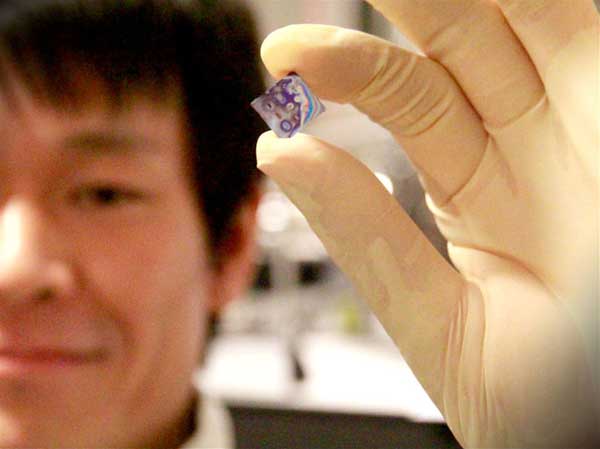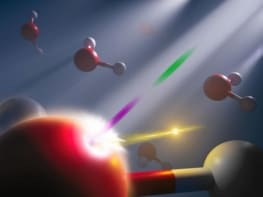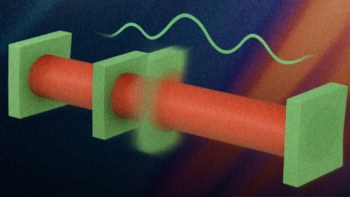
Laser cooling has been used on a solid film of semiconductor for the first time, reducing its temperature to a chilly 4 K. The work has been done by researchers in Denmark, who suggest that with future developments the semiconductor’s temperature could be chilled further so that its vibrations are reduced almost to the quantum ground state in at least one direction. This would allow the semiconductor to sense the slightest of mechanical motions or tiny electrical currents.
In a solid material, thermal energy exists mostly in the form of jiggling atoms. If some of these vibrations are removed, the temperature of the material drops. In this latest study, a group led by Eugene Polzik of the University of Copenhagen reduced the vibrations of a semiconductor membrane that is placed in an optical cavity so that it captures light between two reflectors. While vibrations in materials such as dielectric mirrors and membranes have been damped out by the pressure of photons building up between themselves and a mirror, this latest device exploits the semiconductor’s ability to absorb photons, turning them into electrical excitations.
For the scheme to work, a thin film of high-quality semiconductor must be used. This was created by Peter Lodahl and colleagues, who made a rectangle of the semiconductor gallium arsenide, just over 1 mm to a side but a mere 160 nm thick. The semiconductor is suspended on a square frame such that the rectangle was bowed slightly, creating a concave shape to face the concave mirror that formed the other side of the optical cavity. Thermal vibrations, their amplitude set by the temperature of the semiconductor, caused the membrane to oscillate like a drum, explains Polzik.
Kicking electrons
In the experiment, led by Koji Usami, the team set the distance between the mirror and the membrane to resonate with the light from a near-infrared laser. This is done by making the distance a multiple of half the light’s wavelength. The cavity traps the photons, which are at just the right energy to kick electrons out of the gallium arsenide’s valence band and into its conduction band. If they made just one pass at the gallium arsenide they would stand only an 8% chance of being absorbed. However, because they bounced back and forth between the mirror and the gallium arsenide, each photon’s chance of kicking an electron into the conduction band rises to 50%.
Once the electrons fall back into the valence band, they release their energy as heat and caused the semiconductor film to expand, exaggerating its concave shape. This changes the length of the cavity, diminishing its resonance with the laser so it does not trap light as well. As a result, the semiconductor cools and contracts, improving the resonance once more. These opposing influences tend to dampen the membrane’s oscillations, reducing their amplitude to a temperature equivalent of 4 K.
Polzik acknowledges that their experiment has not set records – other optical cooling methods can bring their targets down to millikelvin temperatures. Even so, Andrew Armour of the University of Nottingham, UK, says that the approach has “interesting possibilities because it involves the electrons and optical absorption of the semiconductor”. He also points out that there is a large body of knowledge in the field of semiconductors, and applying this know-how to optomechanical cooling could push the field forward another step.
Hot or cold?
Hajime Okamoto of Nippon Telegraph and Telephone’s Basic Research Laboratory in Kanagawa, Japan, agrees that exploiting the band gap is intriguing but he points out that the electrons only served to heat the material, and that thermal damping has been demonstrated before.
Polzik’s team suggests that the electrons could be persuaded to stick around rather than dumping their energy as heat. A quantum well, made by placing a 20 nm layer of indium gallium arsenide inside the 160 nm gallium arsenide membrane, could keep the electrons away from the surface of the material, which is where they go to rejoin the valence band. By reducing the overall heat in the material, while still causing it to expand, Polzik is optimistic that this approach could reduce the vibrations further – possibly to millikelvin levels. Alternatively, he says that their findings might inform efforts to cool optically all of the membrane’s vibrational modes through its band gap, reducing its overall temperature.
“Finding a way to cool effectively semiconductor electronics is very important,” says Polzik, adding that overheating has become one of the main barriers to creating faster, smaller devices. Although he calls the idea of laser-cooling electronics “futuristic”, Polzik believes that their experiment is a step in that direction.
This research is published in Nature Physics.



